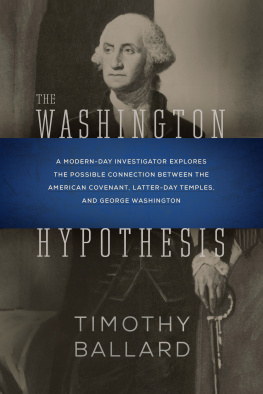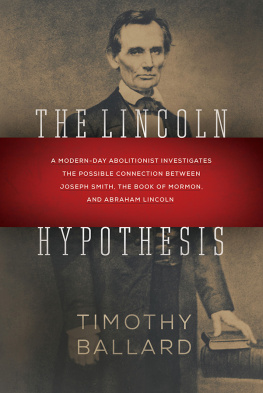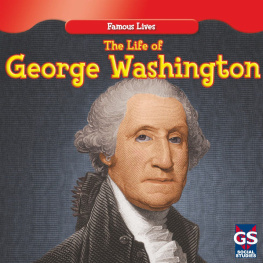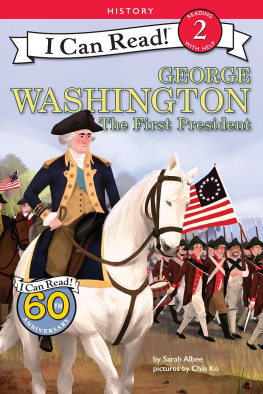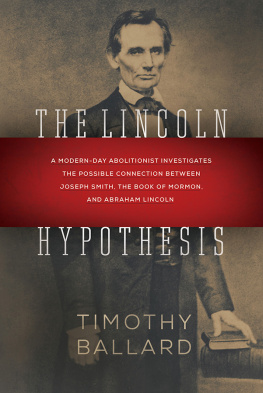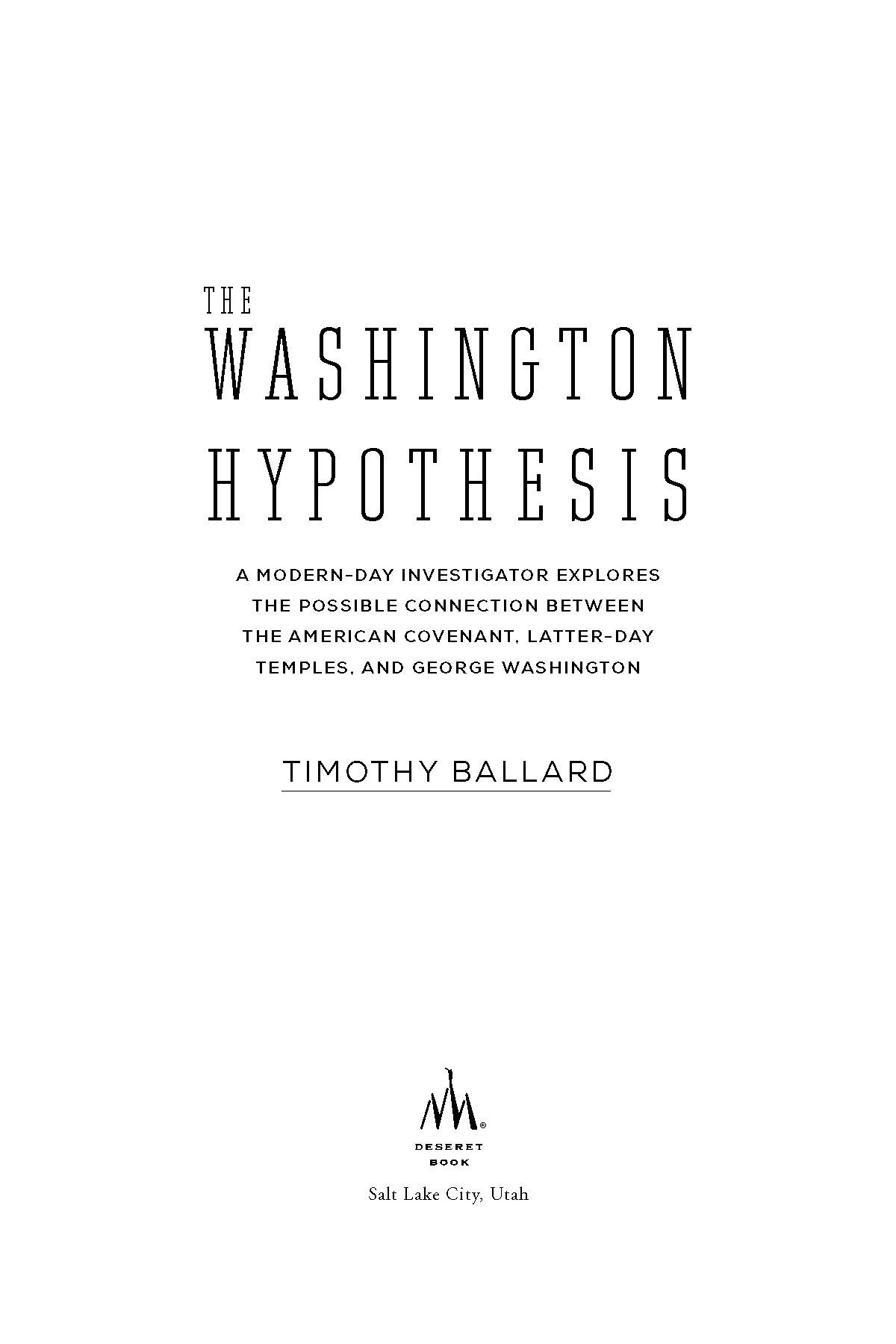2016 Rockwell Group Inc..
All rights reserved. No part of this book may be reproduced in any form or by any means without permission in writing from the publisher, Deseret Book Company (permissions@deseretbook.com), P.O. Box 30178, Salt Lake City Utah 84130. This work is not an official publication of The Church of Jesus Christ of Latter-day Saints. The views expressed herein are the responsibility of the author and do not necessarily represent the position of the Church or of Deseret Book. Deseret Book is a registered trademark of Deseret Book Company.
Deseret Book is a registered trademark of Deseret Book Company.
Visit us at DeseretBook.com
Library of Congress Cataloging-in-Publication Data
Names: Ballard, Timothy, author.
Title: The Washington hypothesis : a modern investigator explores the possible connection between the American covenant, latter-day temples, and George Washington / Timothy Ballard.
Description: Salt Lake City, Utah : Deseret Book, [2016] | ?2016 | Includes bibliographical references and index.
Identifiers: LCCN 2016003792 (print) | LCCN 2016006092 (ebook) | ISBN 9781629721781 (hardbound : alk. paper) | ISBN 9781629734491 (ebook)
Subjects: LCSH: Washington, George, 17321799. | United StatesHistoryReligious aspectsThe Church of Jesus Christ of Latter-day Saints. | United StatesHistoryReligious aspectsMormon Church. | Mormon temples.
Classification: LCC E312.17 .B17 2016 (print) | LCC E312.17 (ebook) | DDC 973.4/1092dc23
LC record available at http://lccn.loc.gov/2016003792
Printed in the United States of America
Publishers Printing, Salt Lake City, UT
10 9 8 7 6 5 4 3 2 1
To my great-grandfather Nephi Anderson, and to all those who have gone before us, whose angelic presences go before us still

Publishers Note
A hypothesis is not a statement of fact, though it often reads like one. It is, rather, a jumping-off point, a tentative assumption made that provides a framework for examining and organizing facts. Most scientific or historical queries begin with a hypothesis, which is calculated based on the facts already known and then either supported or rejected by additional research.
The Washington Hypothesis is a bold conjecture based on extensive historical research. The miraculous events of the Revolution and the remarkable strength of character embodied in George Washington are demonstrable facts. In this gripping book, Timothy Ballard has shared many of those facts and drawn some fascinating conclusions from them. Whether or not you come to the same conclusionswhether you support his hypothesis or notwe believe you will gain a new appreciation for the events that shaped America as a nation and for the greatness of its first president, George Washington.
Prologue

The Window
A few years ago I got a call one day from Todd, my best friend from childhood. Some had predicted the end of our friendship when he started dating my little sister in high school. We proved them all wrong. He even married her after serving an LDS mission, and we stayed as close as ever. So when I saw his name on my caller ID that day, I thought little of it; he called a lot. But this conversation was different than any we had ever had before.
I think I know what the window has been trying to tell us! His usually calm and steady voice was more amped up and excited than I had ever heard it before.
I knew exactly what window he was talking about, and I was thrilled at the prospect that he had perhaps deciphered its rather cryptic meaning. Through the years, Todd and I had talked about the strange window, with its signs and symbols. The reason it had always been forefront in our minds was because we had each looked upon it hundreds of times. It stretched across the wall behind the pulpit in the LDS chapel we attended together as children and teenagers in La Caada, California. I had since moved away from La Caada, but Todd was still there, serving in the ward bishopric, still gazing at the window multiple times a week.
George Washington! he said. All the things you have been telling me about George Washington. They are in the window!
For years, I had been studying and discussing with Todd some interesting connections I had been proposingconnections that linked George Washington with the Book of Mormon and LDS temples in a fascinating way. Needless to say, Todds declaration to me was more than intriguing.
As I listened to Todd, my mind shot back to a childhood memory that marked my first serious experience with the window. I was only eleven years old on the night that it happened. Somehow this memory was consistent with what Todd was saying. Looking back, I felt as if this window had set my eleven-year-old self on a journey. A journey that has lasted until the present day. A journey I will call the Washington Hypothesis quest.
It all started at a Boy Scout meeting. It began like any other. On that Tuesday night, my dad dropped me off at the La Caada church building as usual. And, as usual, he returned an hour later to pick me up. When I looked up and saw that he had entered the building to retrieve me, my young heart was disappointed. I was hoping he would have arrived later than he did because I was involved in a very fun after-meeting game with my fellow Scouts.
To understand this game (which I had invented and organized for the first time that particular night), and to understand why it proved to be such a pivotal event in my life, you must understand a little bit about the La Caada chapel. At the time, I had not been to many other LDS chapels, so I had no idea what a unique place it was. It had been built in the days when local congregations were charged to get their buildings built with minimal financial assistance from Church headquarters. So local congregations naturally had the opportunity to build more or less what they wanted. This, at times, resulted in the creation of unique buildingsunique in their ability to push the limits of what today many would recognize as more uniform LDS architectural standards. In fact, the La Caada building is so unusual that it has been named as a historic property by the LDS Church History Department.
The building was completed in 1952, just in time for my mother to be the first baby blessed there. My great-grandfather Nephi Anderson had donated the multiacre plot of land for the project. He was the stake patriarch. He was also the general contractor for the building project. These facts are precious to me. They seem to tie me to the building on a deeply emotional level. But it wasnt until the strange discovery I made that night while playing with my fellow Scouts that the building became truly significant to me and set me on a historical journey that has yet to end.
Dad! I yelled out with a tennis ball in my hand, while standing on the far side of the basketball court (or what the adults strangely called the cultural hall) of the church building. How much will you give me if I make this shot?
That was the game I had invented. I admit, it seems too simple to be worthy of the title invention, until you learn what the shot was. And this is where the unique architectural taste of Nephi Anderson comes into play.
You see, the cultural hall in the La Caada building boasts of great beamsvery thick beamsthat rise up and support the high-pitched roof. This was all part of the English Tudor structure that characterized the building. I had been challenging my fellow Scouts to stand near the half-court line, then throw their tennis balls high up against the wall that sat behind the basket. The idea was to make the tennis ball hit on the wall high above and behind the backboard and basket in such a way that it would cause the ball to bounce off and up and hit the tall beam hovering over the court. From there, so my theory went, if the ball hit what I was calling the beams sweet spot, it would then be sent earthbound, bank off the backboard, and shoot right through the iron hoop.

